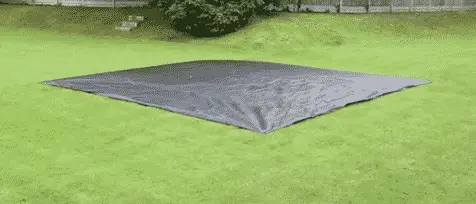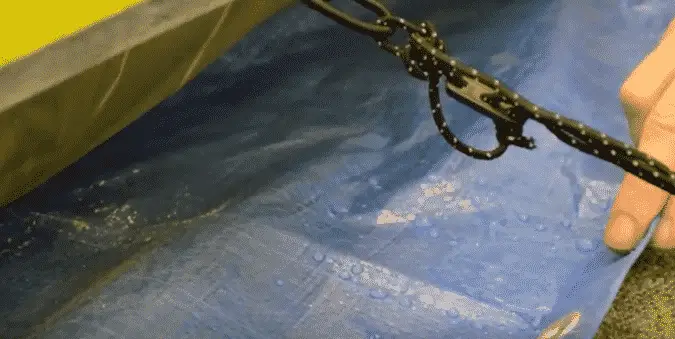Since it’s such a simple piece of equipment there’s really no directions. Is there a right or wrong way to setup your tent footprint? Which side of a Tent Footprint Goes Up?
Which side of a tent footprint goes up? Technically, the waterproof side of your tent footprint should go up towards the sky. This is usually the shiny side that usually has the brand logo on it. Honestly, I really don’t think it makes a difference which side is up.
Does it really make a difference? Probably not! Continue reading for more information on properly setting up your tent footprint.
Which Side Of a Tent Footprint Goes Up?

Tent Footprints are designed to protect your tent against the elements. When the ground isn’t smooth a tent footprint or ground cloth will protect your tent floor against rips and tears. So how do you use a tent footprint?
The Shiny Decorative Side Goes Up
Honestly it really doesn’t matter which side of the Tent Footprint Goes Up. Most manufacturers recommend putting the shiny side with the logo up.
Supposedly the shiny side is coated with waterproofing, but I don’t buy that (it’s probably just so people can see the logo). It doesn’t make sense when you think about the proper way to use a tent footprint.
You shouldn’t be able to see the footprint after setting up the tent. To prevent pooling water the footprint is supposed to be 2-3 inches smaller than the outside diameter of the tent.
It’s only there to prevent mud and accidental punctures. You might want to check out my other post “How Big Should a Tent Footprint Be?“
Setting Up Your Tent Footprint
The rest of the setup process is fairly straight forward.
- First you need to place your footprint/groundsheet wherever you plan on camping. (I’ve been using this cheap footprint) Unless your tent is super expensive you probably don’t need a special footprint. Any cheap blue tarp will work.
- Look at the tarp/footprint and figure out which side is waterproof. Shiny side typically faces up towards the sky.
- Start setting your tent up on top of the ground cloth. Insert your tent poles into the grommets and use the straps for more security. With a tarp you’ll just need to set your tent up and call it a day.
Advantages to Buying a Real Tent Footprint
Throughout the vast majority of my life I’ve been using a tarp instead of a real footprint. On those short weekend camping excursions that was all I really needed.
I never really saw the benefit of dedicated footprints until I started working with ultralight gear. When you have a footprint specifically designed for your tent you can ditch the tent body and only use the rainfly and footprint. Tent poles go right into the grommets and you’ve got a pretty light setup.
You can definitely use a tarp as a tent footprint, but it won’t be optimal. Think about the last time you tried to fold a tarp. Does that sound like something you want to jam inside your pack? I doubt it!
Is a Footprint Really Necessary?
Unless you’re spending big bucks on camping gear the footprint isn’t really necessary. Cheap $20-$30 tents are designed to be disposable so a footprint really won’t help matters. With expensive gear you’re probably going to want a footprint.
Only time you’ll definitely need a footprint is sandy/gravely ground. Sand and gravel will quickly wear away at your tent floor.




